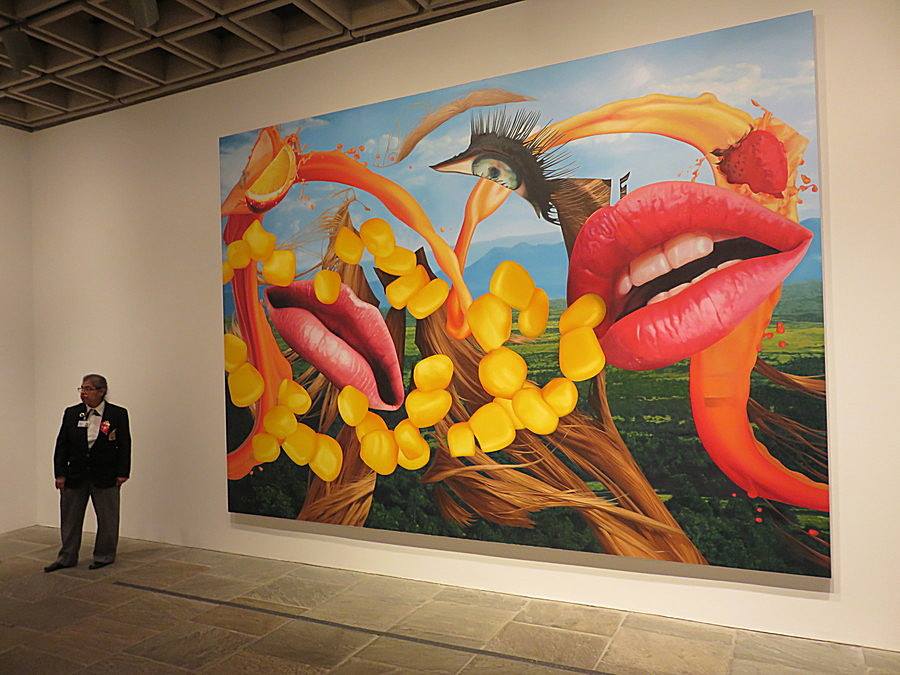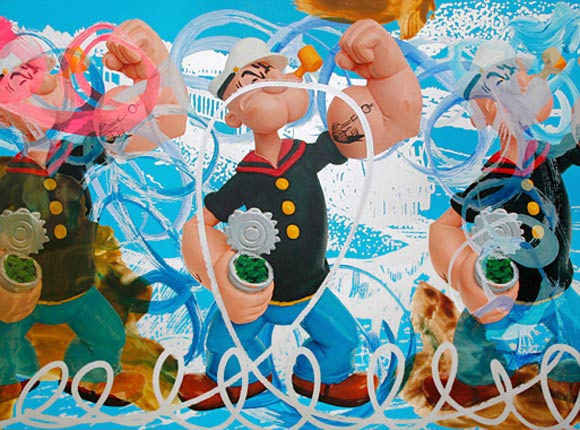Jeff Koons is a cariacature of the art world. A stock trader turned painter in the cocaine driven excesses of the 80s .. He’s an artist that’s extremely easy to hate for a variety of reasons. He’s crude, he’s juvenile, vacuous, an icon of late capitalism, and worst of all he comes off as insincere. Take a look at the video below of Koons’ interview with Art Historian Robert Hughes (I highly recommend watching all of American Visions by the way).
I’m not interested in dissecting deeply the “hidden motives” at play in Koons work. I think the conceptual framework has been better looked at in recent articles that have come out since his retrospective in London. I am interested in looking at what it is that drives us mad about Koons, and what it says about painting today.
Often when the subject of Jeff Koons as a painter comes up, it isn’t long before the fact that he relies completely on the work of studio assistants to make his work is discussed. How can an artist not even touch his own work? A great article on the subject is I Was Jeff Koons’s Studio Serf
Here we are given the account of what it takes to create a Jeff Koons painting. A studio employee is given a very specific task, with specific instructions on how to create the painting. The paint is to be applied in a certain manner, and very specific colors are to be used. One has to wonder if it’s the instructions that turn people off to this mode of creation, or the fact that someone is an employee. If instructions are bad, then why even bother trying to examine how great works of art were made in the past, and attempt to recreate these same working methods? Isn’t this essentially following a set of instructions? As it relates to “employees” (Studio assistants) making a work of art, this also has some historical precedence. It wasn’t uncommon for people like Rembrandt to have an entire studio of artists all working on his paintings. Rembrandt looked at a huge canvas, and saw that a blue gradient needed to painted first and he was like “I aint got time for that” and told one of his assistants to do it. However, there’s one glaring difference between Koons and Rembrandt, and that’s the fact that Rembrandt touched his paintings in the end. Koons never lays a finger on them, he just tells other people what to do.
However, lets think about what’s really wrong with keeping your hands off of a project? Some of the greatest Film directors of all time aren’t splicing film or moving the mouse to edit certain sections of a film. They’re telling other people what to do, and in doing so, they’re trying to make a product that is either A) Marketable or B)Art . In Koons’ case he’s doing both. There’s no doubt that he’s playing with ideas involving consumerism, and it’s not a coincidence that he came to prominence at the height of capitalist excess. So, doesn’t this make him a pretty good artist who was able to catch the zeitgeist of the moment? We shouldn’t be shocked that his aluminum steel bunny set a record at auction. That’s what it was supposed to do. Sure, the reflection in the side of that bunny may represent the vacuous nature of the art market, but it also reflects us.

